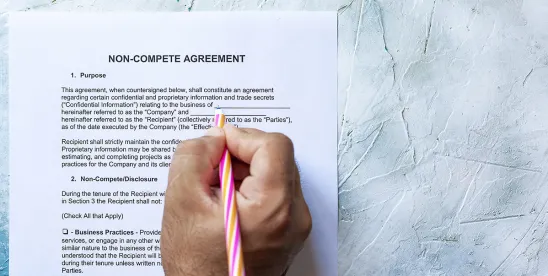On August 20, 2024, in Ryan LLC v. Federal Trade Commission, the U.S. District Court for the Northern District of Texas entered summary judgment in favor of the plaintiffs and set aside the Federal Trade Commission’s (FTC) Final Rule, prohibiting the FTC from enforcing the Final Rule and the Final Rule taking effect nationwide. As succinctly stated by the district court in its decision, “The Court sets aside the Non-Compete Rule. Consequently, the Rule shall not be enforced or otherwise take effect on its effective date of September 4, 2024, or thereafter.” Decision at 2.
Background
As we reported in January 2024, April 2024, and July 2024, the FTC issued the Final Rule on April 23, 2024, banning nearly all worker non-compete agreements nationwide effective September 4, 2024.
On July 3, 2024, the Ryan court enjoined the FTC from implementing or enforcing the Final Rule against only the plaintiffs in that case. Importantly, the July 3rd ruling did not restrain the FTC from enforcing the Final Rule against other employers. At that time, the court stated it intended to issue a decision on the ultimate merits of the case by August 30, 2024, a promise it made good on this week.
The Court’s Memorandum and Order
In its August 20th decision, the court mainly followed the same analysis it outlined in its July 3rd order that the FTC had exceeded its statutory authority in issuing the Final Rule and, further, that the Final Rule is arbitrary and capricious.
In determining that the FTC exceeded its statutory authority, the court focused on the text of the FTC Act and, in particular, Section 5 that authorizes the FTC to address “unfair methods of competition in or affecting commerce and unfair or deceptive acts or practices in or affecting commerce,” see 15 U.S.C. § 45(a)(2); and Section 6 that arms the FTC with powers to investigate and also to “make rules and regulations for carrying out the provisions” of the Act. See 15 U.S.C. § 45(g). Contrary to the FTC’s arguments that the text of the FTC Act grants it broad rulemaking powers, the court instead interpreted the FTC Act as limiting the FTC to adjudicative rulemaking. The court framed the issue as: “The issue presented is whether the FTC’s ability to promulgate rules concerning unfair methods of competition include the authority to create substantive rules regarding unfair methods of competition.” Decision at 16. The court answered: “[A]fter reviewing the text, structure, and history of the Act, the Court concludes the FTC lacks the authority to create substantive rules through this method.” Decision at 17. The court also noted the absence of any penalty provisions, demonstrating the absence of substantive rulemaking power. The court also observed that the section relied upon by the FTC for authorizing substantive rulemaking authority was seventh in a list of twelve almost entirely investigative powers, suggesting that the FTC was placing too much reliance on that section. The court also considered the Act’s structure, which did not support the FTC’s interpretation, and its history, which revealed a 40-year span where the FTC did not issue any substantive rules.
In determining the FTC Final Rule was arbitrary and capricious, the court found the Final Rule “unreasonably overbroad without a reasonable explanation.” Decision at 23-24. It imposes a “one-size-fits-all approach with no end date, which fails to establish a ‘rational connection between the facts found [by the FTC supporting the rule] and the choice made.’” Decision at 24 (quoting Motor Vehicle Mfrs. Ass’n of U.S., Inc. v. State Farm Mut. Auto. Ins. Co., 463 U.S. 29, 43 (1983)). The court criticized the “handful of studies” relied on by the FTC for the noncompete rule. The court recognized that most states allow and regulate noncompete agreements but that “no state has ever enacted a noncompete rule as broad as the FTC’s Rule.” Decision at 24. The court also criticized the FTC’s decision to ignore specific factual situations for allowing noncompete agreements under state law in favor of the FTC’s categorical ban on noncompete agreements. As explained by the court, “The Commission’s lack of evidence as to why they chose to impose such a sweeping prohibition – that prohibits entering or enforcing virtually all non-competes – instead of targeting specific, harmful non-competes, renders the Rule arbitrary and capricious.” Decision at 24. As it stated, “In sum, the Rule is based on inconsistent and flawed empirical evidence, fails to consider the positive benefits of non-compete agreements, and disregards the substantive body of evidence supporting these agreements.” Decision at 24 (footnote omitted). A second basis for holding that the Final Rule is arbitrary and capricious was that the FTC had failed to sufficiently address alternatives, never conducting any analysis but instead merely stating that “case-by-case adjudication of the enforceability of non-competes has an in terrorem effect that would significantly undermine the [FTC’s] objective to address non-competes’ tendency to affect competition. Decision at 25. The court noted the FTC dismissed possible alternatives, concluding that pro-competitive justifications outweighed the harms or that employers had other avenues to protect their interests. Decision at 25.
What Happens Next
At this point, the Final Rule has been set aside and is unenforceable against any employer. However, the FTC may nevertheless have the authority to prosecute discrete cases against employers for violating Section 5 by engaging in “unfair methods of competition in or affecting commerce and unfair or deceptive acts or practices in or affecting commerce.”
In addition, the FTC may decide to appeal the court’s decision. If the FTC appeals, the appeal would be resolved by the U.S. Court of Appeals for the Fifth Circuit. The parties thereafter may be able to seek review by the U.S. Supreme Court.
Employers or individuals with questions about the FTC Final Rule, or the court’s recent decision, should consult with competent legal counsel.





 />i
/>i
